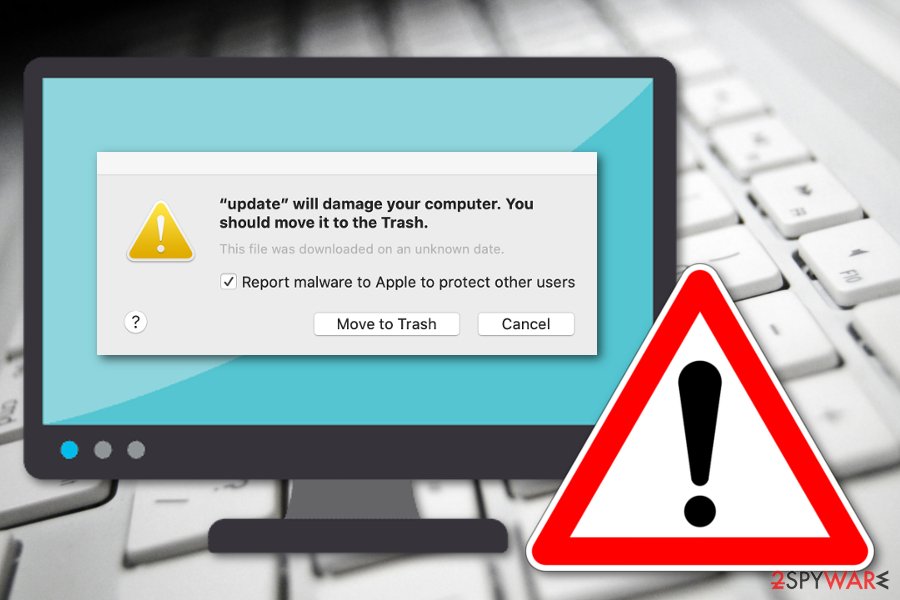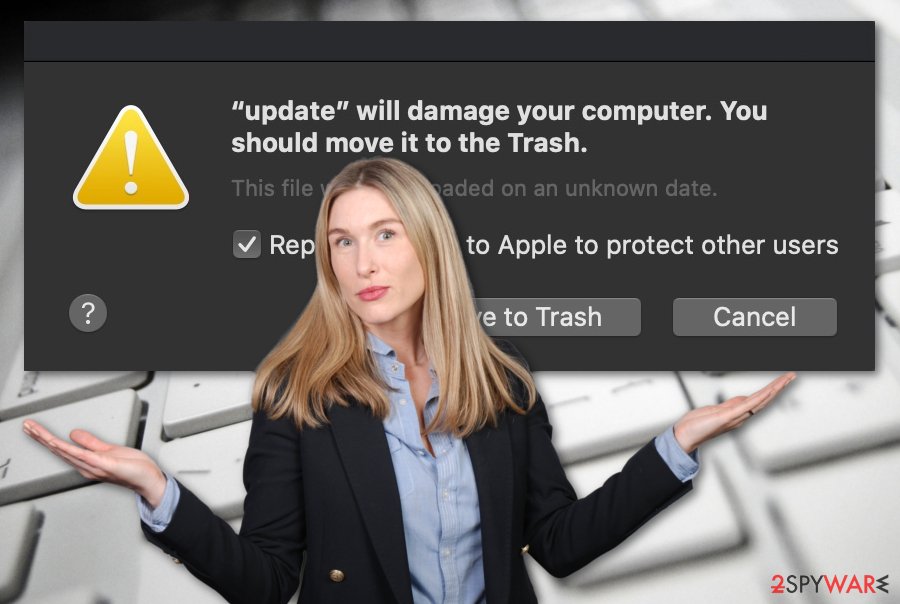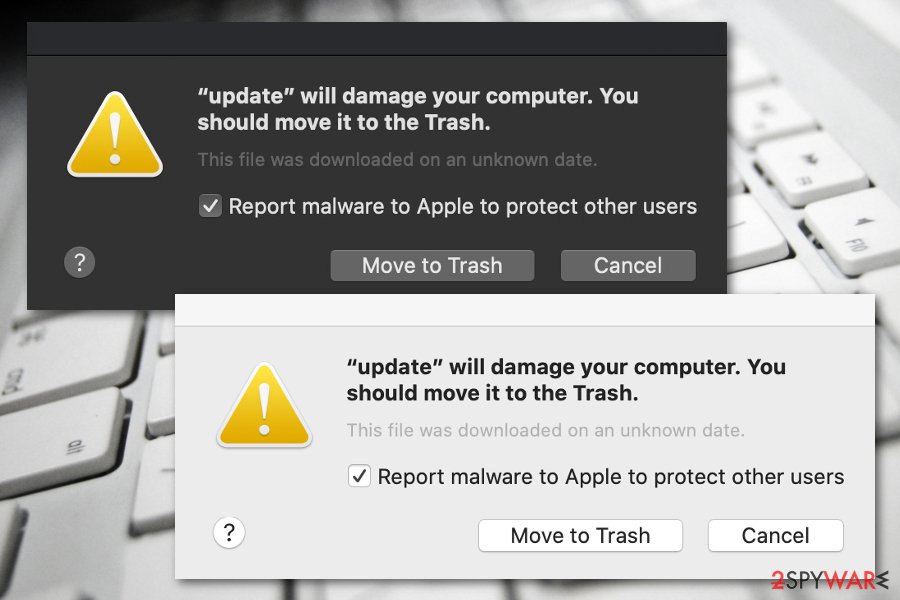Will damage your computer – a bogus pop-up targeting macOS Catalina version

Will damage your computer. You should move it to the Trash – a rogue message that might be related to Helperamc or other suspicious products
“Will damage your computer. You should move it to the Trash” is a suspicious message that appears on macOS Catalina-based computers. The note can come up with the help of any type of program or just a random name, for example, “Helperamc” “Helpermcp“, “APMHelper”, “update” will damage your computer,” etc. This type of pop-up might appear on the macOS Catalina[1] system after downloading adware, browser hijacker, or another potentially unwanted application unknowingly. If P will damage your computer, hlpradc will damage your computer or similar phrase comes up, beware that it comes from a certain type of PUP that might start causing other unpleasant activities, such as frequent advertising, redirecting, major browser changes, sluggish computer work, and similar.
| Name | Will damage your computer. You should move it to the Trash |
|---|---|
| Other names | P will damage your computer, hlpradc will damage your computer, etc. |
| Type | Mac virus |
| Target | This suspicious pop-up notification appears on computers that are running the macOS Catalina operating system version |
| Possible relations | The dubious message can come by mentioning any type of app name, for example, Helperamc, Helpermcp, APMHelper, etc. |
| Cause(s) | This notification can bombard the user’s computer screen if an adware program or another similar PUP has been provoking its appearance |
| Activities | You might additionally experience advertising, redirecting, and browser monitoring if some type of PUP is behind the appearance of “Will damage your computer. You should move it to the Trash” virus |
| System checkup | Run a thorough system scan with a tool such as Reimage Reimage Cleaner and discover the cause of this pop-up |
| Removal process | Employ reputable antimalware software to eliminate the bogus product or use step-by-step guidelines that are added to the end of this article |
If your macOS is based on a different version than Catalina, you might still experience a similar but little bit different pop-up message. Instead of seeing “Will damage your computer”, you will be provided with “Will damage your computer. You should move it to the Bin” notification on your computer screen.
However, if you are running macOS Catalina on your machine, do not be surprised to see “Will damage your computer. You should move it to the Trash” if you have found a potentially unwanted program lurking on your machine system lately. Apple users have reported having experienced this type of pop-up lately:[2]
“update” will damage your computer. You should move it to the Trash.
This file was downloaded on an unknown date.
Report malware to Apple to protect other users.
If there is a potentially unwanted program that ha been provoking “Will damage your computer. You should move it to the Trash” to appear, you might start experiencing various unpleasant activities and changes in your machine or browser apps. For example, adware is known to bombard users with a big number of pop-ups and pop-unders for collecting money via the pay-per-click scheme.

Will damage your computer. You should move it to the Trash is a suspicious notification that might be provoked by an adware program
Furthermore, the “Will damage your computer” appearance might be accompanied by redirecting activities during your browsing sessions. PUP developers plant bogus extensions and plug-ins into targeted web browsers that provoke redirecting activities. Even though such a task is programmed to take you to affiliate sources, you also might land on a potentially infectious source.
Continuously, the bogus program that is hiding behind “Will damage your computer. You should move it to the Trash” pop-up, might perform suspicious changes on your web browsers. Major setting modifications will supposedly be spotted on the homepage and new tab search zones. Besides, users might discover browser helper objects some of which might be tracking cookies.
Developers who support various adware programs plant HTTP cookies[3] on the browsers to be able to collect browsing-based information that later on can be successfully used in targeted ads campaigns. You should remove “Will damage your computer. You should move it to the Trash” with the program that is provoking its appearance if you want to have a fully-optimized machine and be able to carry out browsing tasks in full quality.
You can shorten the “Will damage your computer” removal for your macOS system by launching a reliable anti-virus. Try SpyHunter 5Combo Cleaner for this task. Scan the system further with Reimage Reimage Cleaner to detect the corrupted files and other damaged components on the system.

Spreading methods used by PUP developers. Avoid sneaky products
Security researchers from ZonderVirus.nl[4] claim that PUP spreaders think of more than one technique that would successfully distribute their developed products. However, the most common sources used for PUP distribution are these ones:
- Software bundling. When the bogus app comes as an additional product within a particular software package. You increase the chances of receiving a potentially unwanted program if you download apps from Softonic, Cnet, etc.
- Third-party links/ads. You can easily get a potentially unwanted application installed through a questionable hyperlink or advertisement that has been provided to you on a security-lacking website.
- Fake software updates. False upgrades such as Flash Player ones and similar are often lurking on the web sphere. If you proceed with a questionable updating process, you might accidentally launch the installation of adware.
The best way to secure your system and its products from suspicious cyber attacks is to combine manual and automatical security. Download and install a reliable antimalware tool that will keep your machine protected 24/7 from potential threats, include the safe browsing feature, and allow you to perform regular computer checkups.
Continuously, while downloading software make sure that you get your product from a reliable source and always use the Custom/Advanced installation mode instead of the Quick/Recommended configuration. Additionally, avoid visiting unsecured websites that look concerning to you and always perform regular software updates to avoid fake program upgrades.
Get rid of “Will damage your computer. You should move it to the Trash” from macOS systems
“Will damage your computer. You should move it to the Trash” removal is the thing you need to focus on while dealing with this suspicious pop-up notification. The PUP that has been hiding behind this message can be terminated by using automatical software os manual guidelines.
Below you will find step-by-step instructions on how to remove “Will damage your computer” virus from your macOS and clean web browsers from suspicious products. In case the PUP has inserted bogus extensions or add-ons into your browser apps, you need to refresh them too.
However, if you are a less-experienced user, finding the cause of “Will damage your computer. You should move it to the Trash” virus might be a little bit difficult for you. In this case, we recommend employing reputable antimalware software.
You may remove virus damage with a help of Reimage Reimage Cleaner . SpyHunter 5Combo Cleaner and Malwarebytes are recommended to detect potentially unwanted programs and viruses with all their files and registry entries that are related to them.

